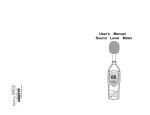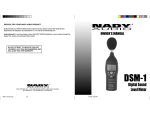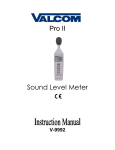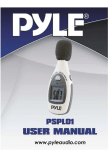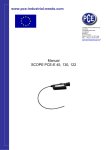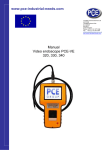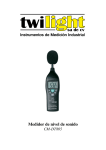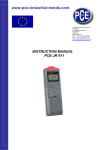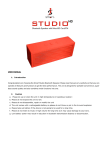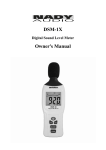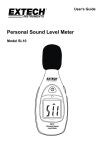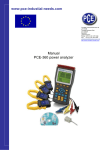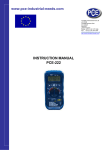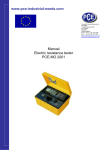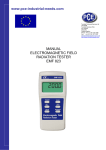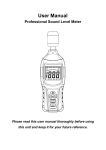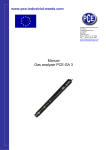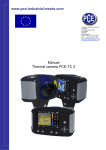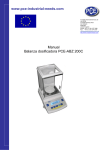Download PCE-999 sound level indicator
Transcript
www.pce-industrial-needs.com Tursdale Technical Services Ltd Unit N12B Tursdale Business Park Co. Durham DH6 5PG United Kingdom Phone: +44 ( 0 ) 191 377 3398 Fax: +44 ( 0 ) 191 377 3357 [email protected] http://www.industrial-needs.com/ Manual Sound level indicator PCE-999 [email protected] 1. 2. 3. 4. 5. 6. 7. 8. Safety information .......................................................................................................... 2 General Description........................................................................................................ 2 Specifications ................................................................................................................. 2 Name and Functions ...................................................................................................... 3 Measurement Preparation ............................................................................................. 4 Operating Precautions ................................................................................................... 4 Measurement .................................................................................................................. 4 Calibration Procedures .................................................................................................. 5 1. Safety information Read the following safety information carefully before attempting to operate or service the meter. Use the meter only as specified in this manual; otherwise, the protection provided by the meter may be impaired. z Environment conditions 1 Altitude up to 2000 meters 2 Relatively humidity 90% max. 3 Operation Ambient 0~40 z Maintenance & Clearing 1 Repairs or servicing not covered in this manual should only be performed by qualified personnel. 2 Periodically wipe the case with a dry cloth. Do not use abrasives or solvents on this instruments. z Safety symbols Meter is protected throughout by double insulation or reinforced insulation. When servicing, use only specified replacement parts. Comply with EMC 2. General Description Thank you for using our Sound Level Meter. To ensure that you can get the most from it, we recommend that you read and follow the manual carefully before use. This unit conforms to the IEC651 type 2, ANSI S1.4 type 2 for Sound Level Meters. This Sound Level Meter has been designed to meet the measurement requirements of safety Engineers, Health, Industrial safety offices and sound quality control in various environments. z Ranges from 30dB to 130dB at frequencies between 31.5Hz and 8 KHz. z Display with 0.1dB steps on a 4-digits LCD. z With two equivalents weighted sound pressure levels, A and C. 3. Specifications • • • • • • • • • • • Standard applied: IEC651 type 2, ANSI S1.4 type 2 Frequency range: 31.5Hz~8KHz Measuring level range: 30~130dB Frequency weighting: A/C Microphone: 1/2 winchs électret condenser microphone Calibration: Electrical calibration with the internal oscillator (1kHz sine wave) Display: LCD Digital display: 4 digits Resolution: 0.1dB Display Up data: 0.5 sec. Time weighting: FAST(125mS), SLOW(1 sec.) 2 [email protected] • • • • • Level ranges: Lo: 30-100dB Hi: 60-130dB Accuracy: + 1.5dB (under reference conditions) Alarm function: “OVER” is show when input is out of range Maximum hold: Hold readings the Maximum Value, with decay < 1dB/3minutes. • • • • • • • • • • Auto power off: Meter automatically shuts down after approx. 15 minutes of inactivity. Power supply: One 9V battery, 006P or IEC 6F22 or NEDA 1604. Power life: About 50hrs(alkaline Battery) Operation temperature : 0 to 40 (32 to 104oF) Operation humidity : 10 to 90%RH Storage temperature: -10 to 60 ( 14 to 140 oF) Storage humidity: 10 to 75%RH Dimensions: 210(L)X55(W)X32(H)mm 230g(including battery) Weight: 9V battery, carrying case, Instruction manual… 4. Name and Functions ① Windscreen If you operate at wind speed over 10m/sec, please put protective accessories in front of the microphone. ② Display S F dB BAT SYMBOL FUNCTION LCD MAX OVER F S A C Lo Hi BAT 4digits Maximum Value hold Over range Fast response Slow response A-Weighting C-Weighting Low Range (30~100dB) High Range (60~130dB) Low-Battery ③ Power ON/OFF button Turn the meter power ON/OFF ④ Backlight Button: Turn the meter backlight ON/OFF ⑤ A-weighting / C-weighting select button A/C A: A – Weighting. For general sound level measurements. C: C – Weighting. For checking the low- frequency content of noise. (If the C-Weighted level is much higher than the A-Weighted level, then there is a large amount of lowfrequency noise) 3 [email protected] ⑥ Time weighting select button F/ S F (fast response): for normal measurements (fast varying noise) S (slow response): for checking average level of fluctuating noise ⑦ Level range select button Lo/Hi Lo: 30~100dB; Hi: 60~130dB When “OVER” is indicated, the ranges switch to another range for measurement. ⑧ MAX/ Hold button MAX/HOLD The max. Hold position is used to measure the maximum level of sounds. The maximum measured level is up dated continuously. Press once again the button, will release the hold and allow a further measurement. Data Hold button: Press and hold the Button for over 2 second to turn on or off data hold function. The hold function freezes the reading in the display. ⑨ Microphone 1/2 inch Electret Condenser microphone ⑩ Battery Cover 5. Measurement Preparation (1) Battery loading: Remove the battery cover on the back and put in one 9V Battery. (2) Battery Replacement: When the battery voltage drops below the operating voltage, mark “BAT” appears. If it appears, battery should be replaced with new one. 6. Operating Precautions (1) Wind blowing across the microphone would bring additional extraneous noise. Once using the instrument in the presence of wind, it is a must to mount the windscreen to not pick up undesirable signals. (2) To achieve more accurate measurement, use an extension cable to separate the Microphone from the main body so that the effect of unexpected sound reflection can be eliminated. (3) Calibrate the instrument before operation if the instrument was not in use for a long time or operated at bad environment. (4) Do not store or operate the instrument at high temperature and high humidity environment. (5) Keep microphone dry and avoid severe vibration. (6) Please take the battery and keep the instrument in low humidity environment. When not in use. 7. Measurement (1) Open battery cover and install a 9-volt battery in the battery compartment. (2) Turn on power and select the desired response Time and weighting. If the sound source consists of short bursts or only catching sound peak, set response to FAST. To measure average sound, use the slow setting. Select A- weighting for general noise sound level and C- weighting for measuring sound level of acoustic material. (3) Select desired Level (4) Hold the instrument comfortably in hand or fix on tripod and point the microphone at the suspected noise source, the sound pressure level will be displayed. (5) When MAX (maximum hold) mode is chosen. The instrument captures and holds the maximum noise level for a long period using any of the time weightings and ranges. (6) When HOLD (data hold )mode is chosen.The hold function freezes the reading in the display. Press the HOLD button momentarily to activate or to exit the HOLD function (7) Turn OFF the instrument and remove and remove battery when not in use. 4 [email protected] 8. Calibration Procedures Using a standard Acoustic Calibrator (94dB, 1kHz Sine wave) (1)Make the following buttons and function switch settings. Display: dB, A, Hi or Lo, F Function: A-Weighting Response Time: FAST Level range: 30 to 100dB(Lo) or 60 to 130dB(Hi) Measurement mode: MAX Hold and Data Hold Mode function disable. (2) Insert the microphone housing carefully into the insertion hole of the calibrator. (3) Open battery cover and remove the battery to adjust the CAL94dB potentiometer of the unit. The level display will indicate the desired level. Our products are all well calibrated before shipment. Recommended Recalibration cycle:1 year. In this direction will find a vision of the measurement technique: http://www.industrial-needs.com/measuring-instruments.htm NOTE: "This instrument doesn’t have ATEX protection, so it should not be used in potentially explosive atmospheres (powder, flammable gases)." 5





